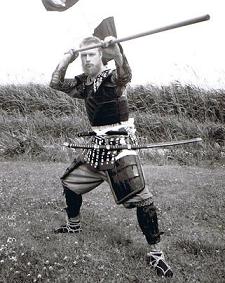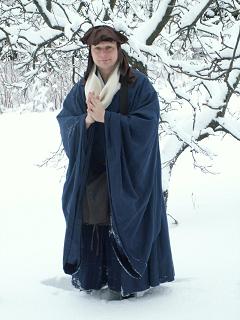The
Iaido Journal Oct 2008
One on One with
Såzen Larsen Kusano Sensei
(Sugino branch, Katori Shinto Ryu)
Part Two: About Katori Shinto Ryu,
Zen, and Training
copyright
© 2008 Douglas Tong, all rights reserved
The
following article is the second part of an interview with Såzen
Larsen Kusano Sensei (5th dan) of the Sugino branch of
Katori Shinto Ryu. In this part, Såzen Sensei talks a little
about Katori Shinto Ryu, Zen, and teaching and learning. Those
interested in learning more about Såzen Sensei can consult his
group’s website: http://www.kakudokan.no/
Author’s
note: This interview was conducted on August 6, 2008 in Toronto,
Canada. Såzen (pronounced “Sozen”) Sensei came over
to Canada to conduct a special seminar in Katori Shinto Ryu.
Question:
In Katori Shinto Ryu, there is an importance placed on kamae. Why is
kamae important?
Sensei:
Actually, any point where you are holding a sword can be considered a
position (i.e., kamae). Katori Shinto Ryu teaches us to be
able and to be ready to move, attack, and defend from any position.
Your body needs to be ready. Your mind needs to be ready.
Question:
Katori Shinto Ryu involves study in many different types of weapons.
Other than the sword, what is your next favourite weapon?
Sensei:
Personally, I like the bo* (6 foot wooden staff).

Question:
Why is that?
Sensei:
It’s such a primitive weapon. Just a long stick with two blunt
ends. There are more elaborate weapons with blades on them like the
naginata and the spear, which you can cut and stab with. But the bo
is so primitive. It’s just a stick… but yet….wow.
(*Såzen
Sensei can be seen performing bojutsu on the only official video of
Sugino-style Katori Shinto Ryu, filmed when the late Yoshio Sugino
Sensei was alive:
http://budogu.com/shopsite_sc/store/html/product728.html
)
Question:
You are a Zen Buddhist priest*. Are there concepts in Zen that you
apply, consciously or unconsciously, to swordsmanship?
Sensei:
Actually, Zen only means that you are aware. That you are conscious
of something. So if you are practicing something and are not aware of
it, you’re in trouble! (Laughs)
Unless, of
course, you are a master of it, then that is something else entirely.
Moment
by moment, you are “present”. That is Zen.
So to
bring that back to swordsmanship, you must “look”…
and “look” again, as O-Sensei said…
(* Såzen
Sensei is also a Zen Buddhist priest in Norway. Those interested in
learning more about Reverend Såzen and his Order can visit his
Order’s website:
http://www.sotozen.no/international-norway.lasso
)
Question:
As a teacher, what do you try to teach your students, apart from just
technique?
Sensei:
Martial arts training is not about winning a war. Training in budo is
about communication, in my opinion. Words are exchanged with
swords or other weapons. It is an exchange between two people.
You need
to respect the other person, their ability. In old budo, because
there is no competition, unlike sports, the idea is to help your
partner become better. And it goes both ways. You help them improve,
they help you improve. The goal is to improve, by respect and
by tolerance.
Tolerance
is important. Even if you don’t have a chemistry with this
person, you shouldn’t say, “I don’t want to
practice with this person.” Because training in budo is not a
solo thing, we need to appreciate our partners.
Even for
teachers, if you want to teach it, you need students, you need
partners. So, tolerance and respect are very important in budo in
many ways.

Question:
As a teacher, what do you believe is most important for students to
remember when studying kenjutsu (or budo)?
Sensei:
First, thinking is not good.* Do what you’re told.
Follow that. Just do it.
(*
possibly Sensei means from a Zen perspective. In other words,
over-intellectualizing things, over-thinking, instead of “being
in the moment”. Those who are familiar with Takuan Soho’s
treatise Fudōchi
Shinmyō Roku (Divine Record of Immovable
Wisdom) will recall his discussion about the attached mind and the
mind that tarries.)
Second,
persevere. Perseverance is interesting. It is not only about the body
but also about the mind. There is a Japanese proverb: “Keizoku
wa chikaru nari”. It basically means, ”Only by
endless repetition, do you master it.” So don’t be afraid
of doing a kata one more time…
Finally,
don’t get caught up in thinking, “When do I master it?”
Just practice and enjoy it. Eventually you will master it. So the key
thing is: Just do it…
Question:
Thank you Sensei. Those are great words to remember. Thank you for
this interview.
Sensei: My pleasure.
Douglas Tong began his
studies of Katori Shinto Ryu with the late Yoshio Sugino Sensei in
Kawasaki in 1990. Mr.
Tong can be contacted via email at: dmtong@rogers.com